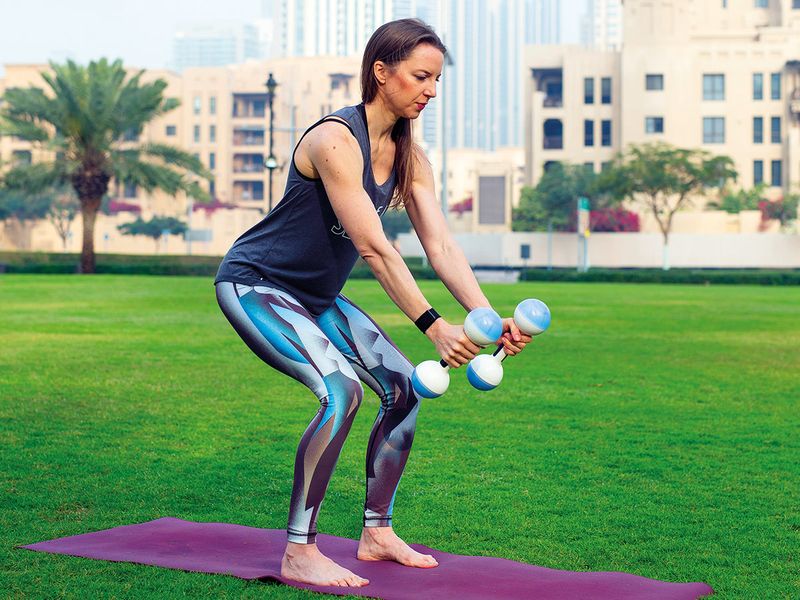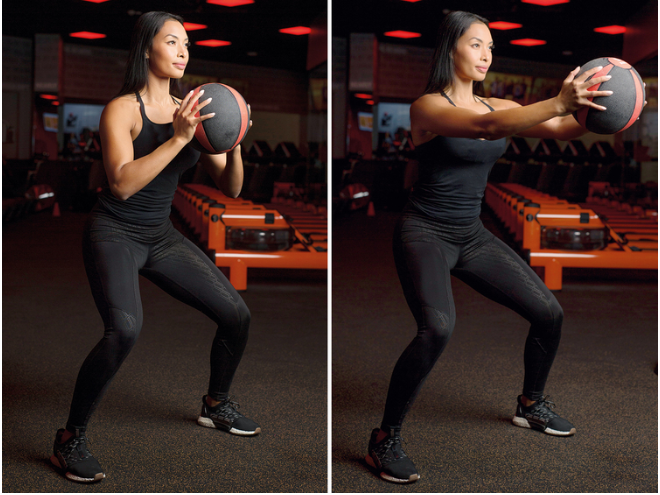No matter where you are or how fit you are, squats should be part of your daily routine
If your image of someone doing a squat is a weightlifter sitting on an invisible chair with a loaded barbell on their shoulder, think again.
By strengthening your legs, glutes and core, squats help develop and maintain lifelong functional fitness — and you can perform them whether you have gym equipment or not.
Here is some information about why everyone should do squats and how to get started.
Squats are a compound movement, meaning they engage more than one muscle group — which translates into a lot of bang for your buck. It doesn’t take many squats to raise your heart rate and fatigue your muscles.
Excellent cross-training for outdoor activities
Not only that, but the strength you develop while squatting will also keep you in shape for virtually any outdoor sport you’re itching to get back to. Squats serve as excellent cross-training for activities such as running, cycling, hiking and rowing.
Squats also prevent the loss of bone and muscle that can lead to falls and fractures. According to the Centers for Disease Control and Prevention, falls are the leading cause of death and injury-related death in Americans ages 65 and older.
Falls often result in broken bones, because an estimated 43.9 per cent of older adults have low bone density, and another 10.3 per cent have osteoporosis.
The surgeon general named osteoporosis, which literally means “porous bone,” one of the most significant contributors to bone fractures in older adults.
When it comes to falls, prevention is the best cure. Trainers and physical therapists tell their older clients that it’s important to perform strength training, and squats in particular, to keep their bones, ligaments and tendons as strong as possible.
Making bones strong
As Nina Geromel, a Milwaukee physical therapist, explains, “Our bones get denser when we use the muscles that pull on the bones.”
Building strong muscles increases your chance of catching yourself if you stumble. And if you do fall, strong bones are less likely to break.
Squats also make you more stable. “The more strong you are in your core, your hips [and] your quads, the more stable you’re going to be walking around on your feet,” says Kristin Oja, an Atlanta-based nurse practitioner and certified personal trainer.
The move, which uses the hips, knees, ankles, glutes, quads and core, supports all kinds of functional fitness. Strengthening the lower body cannot only prevent falls but also make it easier and safer to perform activities of daily living, such as playing with grandchildren, bending down to pick up a basket of laundry, using the toilet, and getting into and out of chairs and cars.
Oja also notes that squats can strengthen the pelvic floor, thereby helping with urinary incontinence and urinary frequency.

Do’s and don’ts
Geromel advises people who are unfamiliar with squatting to “think like you’re sitting in a chair.”
Begin by standing with your feet about hip-width apart and bending forward from the hips while keeping your shoulders back and your chest up.
While leaning forward, bend your knees while keeping them over your toes. Keeping your knees aligned with your toes prevents them from falling inward, which can put undue strain on your knees.
It’s also important to keep most of your weight in your heels, as opposed to the balls of your feet. Having trouble keeping your heels on the ground?
First, make sure you’re really hinging at your hips, Geromel says. If your heels are still coming up, she suggests seeing a physical therapist to address the culprit (typically tightness in the calf, Achilles’ tendon or ankle joint).
Although you’ll feel the burn mostly in your glutes and quads, if you feel it in your abdominals as well, Oja says, that’s a sign that you’re doing it right.
Many people “have a tendency to let their core just kind of hang out and roll their shoulders forward,” Oja says. She says to “roll those shoulders back” before initiating the squat and to keep the core tight throughout.
If you have never performed a squat or have any safety concerns, Geromel and Oja recommend squatting in front of a counter top that you can hold onto with a sturdy chair behind you, particularly if you live alone. That way, if you do fall, you will fall onto a chair.
That said, if dizziness or a tendency to fall interfere with your ability to squat safely, you should address those issues with your medical provider before beginning to add squats to your workout routine.
Although it’s normal to feel some discomfort with any exercise, pain signals a problem. When you’re moving, there shouldn’t be pain unless it’s muscle soreness, which typically feels like fatigue or burning in your legs and glutes.
If you’re experiencing stabbing sensations or a dull ache in your joints, experts suggest consulting a health care provider to address the cause.
If you’re cleared to go ahead with workouts, they say, then consult a physical therapist or personal trainer who can give you exercises that target the same muscle groups without causing pain.
MORE ON THE TOPIC
- Be Fit, Be Safe campaign launched in Dubai urging people to exercise at home
- COVID-19: What will our new normal feel like?
- Stretch your way to basic fitness, says UAE Team Emirates boss
Oja and Geromel suggest working with a physical therapist before you add squats into your routine if you have a history of knee problems, including a total or partial knee replacement, a torn ACL or any other knee injuries.
Anyone with knee issues, Geromel says, should be especially mindful of their form. But, she says, “depending on why they have the knee pain, squatting can actually be a really healthy exercise.”
She explains that for people with mild chronic knee pain (as long as squatting doesn’t exacerbate the pain), doing squats can strengthen the muscles surrounding the joints, thereby reducing pressure on them and alleviating the pain.
Creating a routine
Geromel performs an initial assessment with her patients to see how many times they can safely stand up from a chair in 30 seconds. If you can safely perform 12 repetitions or fewer in the allotted time, she recommends squatting without weights and holding onto a sturdy table or counter for additional support if needed. Try building up to four sets of 12 to 25 repetitions, with 15 to 30 seconds of rest between sets.
Once you can comfortably perform more than 12 sit-to-stands in 30 seconds, you can add weight to your squat.
“And it can be anything,” says Geromel, who suggests holding a heavy encyclopedia or a gallon jug of water (which weighs a little more than 3kg when full) to your chest if you don’t have dumbbells.
When using additional weight, Geromel suggests shooting for three to five sets of six to 10 reps with about a minute of rest, or more if you need to catch your breath, between sets.
If you find six reps to be too challenging — if you cannot maintain good form or you need to pause to catch your breath — the weight is too heavy. If 10 feels easy, Geromel says, “it’s time to bump it up.”
Geromel and Oja recommend squatting three to five times a week. For those using only body weight, five times a week is reasonable, but if you’re lifting heavier weights, Oja says, your muscles need 48 hours to recover between sessions.
To make your squats more challenging, you can easily modify them even without fitness equipment. Oja suggests standing up to a calf raise as you come up from your squat or touching the ground as you come down, and raising your arms overhead as you come to the top of the movement.
You can also go right into a vertical jump as you stand up from your squat; this is called a squat jump. If that’s still not hard enough, try the squat jump while wearing a heavy backpack.
No matter where you are in your life or how fit you are, squats should be part of your routine. When I asked Geromel if there was anyone who shouldn’t perform the exercise, her answer was simple: “No one.” She explains, “We do it every day, and there’s no way to avoid squatting.”



